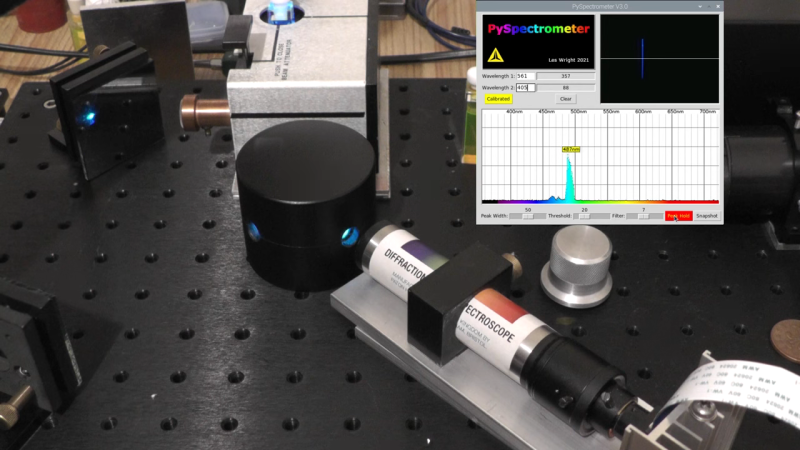It’s an age-old riddle: if you have a perfect sphere with a perfectly reflective inner surface, will light bounce around inside it forever? The answer is pretty obvious when you think it through, but that doesn’t mean that you can’t put the principle to use, as we see with this homemade Ulbricht sphere for optical measurements.
If you’ve never heard of an Ulbricht sphere, don’t worry — it’s also known as an integrating sphere, and that makes its function a little more apparent. As [Les Wright] explains, an integrating sphere is an optical element with a hollow spherical cavity that’s coated with a diffusely reflective coating. There are two ports in the sphere, one for admitting light — usually from a laser — and one for light to exit. The light bounces around inside the sphere and becomes perfectly diffuse, and creates a uniform beam at the exit port.
[Les]’ need for an integrating sphere comes from the desire to measure the output of some of his lasers with his Raspberry Pi-based PySpectrometer. Rather than shell out for an expensive commercial integrating sphere, or turn one on a lathe, [Les] turned to an unlikely source: cannonball molds. The inside of the mold was painted with an equally unlikely ultra-white paint concocted from barium sulfate and PVA glue. With a few ports machined into the mold, it works perfectly to diffuse the light from his dye lasers for proper measurements.
Lasers can be an expensive hobby, but [Les] always seems to find a way to make things more affordable and just as good. Whether it’s homemade doorknob caps for high-voltage power supplies or blasting the Bayer filter off a cheap CCD camera, he always seems to find a way.















The link to ” blasting the Bayer filter off a cheap CCD camera” is wrong.
Fixed.
There was a really nice article on a 3d printed integrating sphere written by John Tomes & Christopher Finlayson at Aberystwyth University. They describe using a BaSO4/PVA spray coating, with a tiny bit of alcohol to help wet the BaSO4. It works great, I have made a few spheres based on their process.
Tomes, J., & Finlayson, C. (2016).
Low cost 3D-printing used in an undergraduate project: an integrating sphere for measurement of photoluminescence quantum yield.
European Journal of Physics, 37, [055501].
Freely available full pdf:
https://core.ac.uk/download/pdf/326671533.pdf
He actually cites that as the source of the BaSO4/PVA recipe he used for his coating. I presume in that 3D print you actually dont need the sides to be smooth so the fact of the layer lines dont matter.
Some primer (automotive spray) is applied to the inside of the 3D print before coating with BaSO4. The layer lines don’t have a huge effect anyways, particularly if the sphere is above a few inches, if small print layer heights (or adaptive layer heights) are used. The 3D printed method also allows integrating spheres of arbitrary size, with ports and fixtures as necessary.
The cannonball mold idea is cute and quick. Typically one doesn’t have ports open to the room in that way. The source and detector are usually mounted flush against the sphere, so that outside light like room lights, monitors, etc don’t leak in. Also, the open fraction of the ports should be a limited fraction of the interior surface area of the sphere (nominally a very low fraction) to get best results.
As far as light bouncing around forever….probably impossible. There really is no such thing as perfect reflectivity (surface flaws and most things are only reflective at a very specific wave length. At some point that light bouncing around in there is going to be converted to heat energy and lost. Think of it this way, light is very fast, the sphere is small = lots of bouncing per second. If you lost even .00001 % of the power on each bounce you would approach zero power very quickly if you are not adding power into the system.
A 100% reflective sphere would also mean there is no way to get light to the inside of it or measure what is going on inside. I cannot think of any way you could penetrate that sphere and maintain all of it reflectivity and surface shape it get to 100%.
I used to work for melles griot, and we would characterize these integrating spheres. The laser never left the sphere. the internal surface was a near perfect white coating, a matte surface. The laser would enter, bounce around and diffuse due to the concave surface. A sensor would allow us to tap power readings. How could a laser diffused exit?
Perhaps this engineer should consider updating the lab warning sign in the background– “Do not look into Laser with remaining eye.”
I keep meaning to! At some point I will do a video on Laser safety, some folk are doing ridiculous things on YouTube.